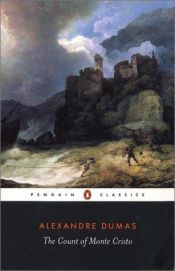The Count of Monte Cristo: Abridged Edition (Dover Value Editions)
Blurb
Greven av Monte Cristo är en roman författad av den franske författaren Alexandre Dumas d.ä. från 1844, först publicerad 1845-46 som romanföljetong i den franska tidningen Journal des débats. Den är en av världens mest lästa äventyrsromaner. Idén "lånade" Dumas från en annan författare, Jacques Peuchet, vilket inte var ovanligt på hans tid då man inte var så noga med upphovsrätten som nu.Romanen utspelar sig i Frankrike i tiden efter den franska revolutionen, åren mellan 1814 och 1838. Landet håller på att byggas upp på nytt under kungarna Ludvig XVIII och Karl X av Frankrike, tills julirevolutionen 1830 åter gör situationen orolig.
Historien innehåller många element som ingår i vad moderna läsare förväntar sig av en äventyrsroman. Den oskyldigt dömde Edmond Dantès, som suttit fängslad i 14 år, förväxlas medvetet från dennes sida med en avliden fånge, och lyckas fly ur fängelset. Den avlidne avslöjade innan sin död platsen där en berömd försvunnen skatt skall finnas, nämligen på ön Montecristo, och när Dantès lyckats fly hittar han den, utnämner sig själv till greve av ön, och med hjälp av pengarna kan han ta ut sin fruktansvärda hämnd.

 English
English Español
Español Deutsch
Deutsch










Member Reviews Write your own review
Alexandru.chereches
Inca o carte ce ne releva natura intunecata a umanitatii si a legilor umane.
Be the first person to review
Sciamatic
One the early adventure novels, 'Monte Cristo' shows its age. While a classic that should be read to understand the beginnings of a now popular genre, the book still suffers from what any progenitor suffers from: a lack of polish. The book contains an abundance of "As you know, Bob..." dialogue, in which two characters who are well familiar with a fact must still discuss it among themselves to let the audience in; or, alternately, dialogue in which the characters speak entirely unnaturally to assuage the audience of their perceptions. For example, the Count is lying about his age. We, the audience, know that. The characters he's deceiving, obviously don't. Rather than simple answer simply, when asked his age, the Count goes through verbal gymnastics to convince a character who has no reason to think he's lying that he isn't lying, because Dumas wants the audience to know that he's thought this all out. It's one of those things that you have to take into account when reading early versions of genre tales -- that the tropes and cliches weren't tropes and cliches yet, and no one knew, or even thought, to avoid them. To me, this makes 'The Count of Monte Cristo' a must read for people wanting to experience the evolution of novel-style story telling, but I don't think this necessarily removes my critique of the writing. While the cliches weren't cliches yet, that doesn't absolve the author of certain crimes. After all, surely Dumas was aware of how people spoke to one another, yet often his characters more woodenly go through puppet plays for his own delight than speaking in any kind of organic manner. In short, I'm very glad to have read this book, and would recommend it to lover's of books, but it is still a bit of a trial to get through, and lacks the charm of other books of the same era.
Be the first person to review
Paula
Genialer Klassiker
Be the first person to review
Pwtierney
Dumas weaves an incredible story. It isn't difficult or especially deep reading; it is a fun, and exciting adventure story meant to entertain more than enlighten. That said, it is done incredibly well, and I'd recommend it for anyone interested in the classical "canon" of adventure novels.
Be the first person to review
Mandavi
Durchaus spannende Geschichte über die großen und reinen Gefühle. Andererseits doch sehr schwarz -weiß und irgendwie recht vorhersehbar, was mich aber nicht vom Mitfiebern abhalten konnte. Und das, nahezu über den ganzen, doch recht beachtlichen Wälzer ;)
Be the first person to review